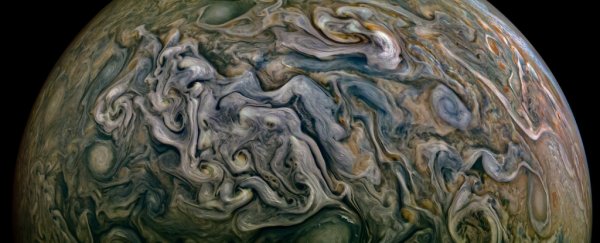On April 10, as we humans were struggling through our new normal in a world wracked by a pandemic, a little space probe millions of kilometres away was marking a mission milestone. NASA spacecraft Juno made its 26th perijove, swooping in for a close flyby of Jupiter.
From this practically cuddling altitude of 4,200 kilometres (2,600 miles), the spacecraft can take close measurements of our Solar System's biggest planet. And, using its JunoCam instrument, it can take photographs that reveal the glorious details of Jupiter's swirling, turbulent clouds.
This image, processed from the raw images by NASA software engineer Kevin Gill and enhanced by space enthusiast Michael Galanin, shows the planet's north, an area raging with intense storms known as a folded filamentary region, the clouds stretched and folded by Jupiter's constant winds.
Jupiter photographed by NASA's Juno spacecraft last Friday
— Space Explorer Mike (@MichaelGalanin) April 15, 2020
Source https://t.co/i3l4alM3qt pic.twitter.com/Zchtfdhmi8
These regions are found at both north and south, right up to the cyclones at each pole, and they are often sprawling, chaotic regions. The rotation usually seen in cyclones only appears sporadically in some substructures; the storms are only partially closed, and they blow turbulent streamers into their adjacent jetstreams.
Although we've known of these regions from Voyager, Cassini and Hubble photographs, Juno has taken the best images of these wild clouds we've ever seen, allowing us to understand them in much greater detail. Juno has also shown us that these storms aren't just skin deep - they can extend up to 3,000 kilometres (1,900 miles) below the cloud tops.
Juno, which arrived in Jovian orbit on 5 July 2016, and made its first perijove on 27 August 2016, will soon be nearing the end of its planned mission. It has less than 10 of these close approaches left.
And the sights it shows us are wonders no humans in the centuries before us have seen.
Unless the mission is extended, the last close approach, Perijove 35, is scheduled to take place on 30 July 2021, when the probe - like Cassini did at Saturn before it - will take a glorious, final plunge deep into the clouds of Jupiter, transmitting as much data as possible before its signal is forever silenced.
